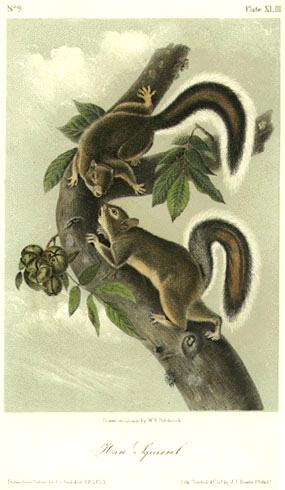

43 Hare Squirrel
SCIURUS LEPORINUS.--AUD. AND BACH
[Tamiasciurus douglasii]
HARE SQUIRREL.
[Douglas' Squirrel]
PLATE XLIII.
S. magnitudine S. cinereum inter et S. migratorium intermedius; cauda
corpore longiore, crassa maximeque disticha; vellere supra ex cinereo fusco;
subtus albo.
CHARACTERS.
Intermediate in size between the Northern gray squirrel and the cat
squirrel. Tail, longer than the body, large and distichous; colour,
grayish-brown above, white beneath.
SYNONYME.
SCIURUS LEPORINUS, Aud. and Bach., Proceedings of the Acad. of Nat. Sci.,
Philadelphia, 1841, p. 101.
DESCRIPTION.
Head, of moderate size; nose, blunt, covered with short hairs; forehead,
arched; eyes, large; whiskers, numerous, extending to the ears; ears, broad at
base, rounded at the edges, and forming an obtuse angle at the extremity,
clothed with sharp hairs on both surfaces. Body, stout, covered by a coat of
thick but rather short hair, coarser than that of the Northern gray squirrel;
limbs, large, and rather long; tail, distichous, but not very bushy.
COLOUR.
Teeth, orange; whiskers, black; nose, dark brown; ears, light brown; behind
the ears, a tuft of soft cotton-like, whitish fur. The hairs of the back are
cinereous at the roots, then light brown, and are tipped with brown and black,
giving it so much the colour of the English hare that we determined to borrow
from it our specific name. On the sides, the colour is a shade lighter than on
the back; the tail, which, from the broad white tips of the hair, has a white
appearance, is brown at the roots, and three times annulated with black. The
upper lips, chin, neck, and whole under surface, including the inner surface of
the legs white; the hair being of this colour from the roots. Feet, dull
yellowish-white. On the outer surface of the hind-leg, above the heel, a small
portion of the fur is brown; there is also a spot of the same colour on the
upper surface of the hind-foot.
DIMENSIONS.
Inches. Lines.
Length of head and body. . . . . . . . . . . 11 9
Length of tail. . . . . . . . . . . . . . 12 6
Height of ear,. . . . . . . . . . . . . . 0 8
Heel to end of middle claw. . . . . . . . . . 2 9
Breadth of tail with hairs extended. . . . . . . 5 6
HABITS.
This species, which is one of our most beautifully furred Squirrels, is
especially remarkable for its splendid tail, with its broad white border. We
know nothing of its habits, as it was brought from California, without any other
information than that of its locality.
We have represented two of these Squirrels in our plate, on a branch of
hickory, with a bunch of nearly ripe nuts attached.
GEOGRAPHICAL DISTRIBUTION.
The range of this Squirrel through California, is, as well as its habits,
totally unknown to us. It will not be very long, however, we think, before a
great deal of information respecting that portion of our continent, so rich in
rare and new species, may be expected, and we should not be surprised to find it
extending toward the south-western portions of Texas, where several species of
Squirrels that we have not obtained, are said to exist.
GENERAL REMARKS.
This species, in its general appearance, so much resembles some varieties
of Sciurus migratorium and S. cinereus, that had it not been for its distant
western locality, we should at first have been tempted to set it down, without
further examination, as one or other of those species. There can, however, be
no doubt, from its differing in size and in so many details of colour from all
other species, that it must be regarded as distinct. It should be further
observed, that S. migratorium has never been found south of Missouri, and that
S. cinereus is not found west of the Mississippi. Indeed, the geographical
range of the latter terminates several hundred miles to the eastward of that
river, and it would be contrary to all our past experience, that a species
existing in one part of our continent should be found in another, separated by
an extent of several thousand miles of intermediate country, in no portion of
which is it known to exist.
|